|
Apulia and Piedmont are two distant regions and very different one from each
other. The former, with its remarkable length, represents the “heel of
Italy”, it is one of the most sunny regions of the country and it is affected
by the influence of seas from which it is surrounded. Piedmont is in the other
side of Italy, in a very different territory, facing the Alps and without
reaching any sea. Both regions have a remarkable richness in grapes and wines -
no region in Italy makes an exception in this - each having its own wine
glories, equally great and extraordinary. Such as Primitivo and Barbera, the
two grapes protagonists of our tasting by contrast, two opposed viticultural
and enological expressions to interpret a wine. Important protagonists in their
respective lands, both have a long and important history in the wine scene of
Italy, giving wines of quite distant characters.
Primitivo is capable of giving wines of good and full body, frequently
characterized by good roundness and a pretty high content in alcohol. Barbera
is very different, mainly known for its typical acidity, a well appreciated
quality by its lovers. The two varieties have a good wine making versatility,
in particular Primitivo which is also used for making robust sweet wines by
using dried grapes. For the sake of truth, it should be said Barbera too,
although marginally, is used for the production of sweet wines. Barbera and
Primitivo are produced both in inert containers and those made of wood,
including the barrique, therefore proving - in both cases - a good versatility
in wine making. They however are two grapes and wines distant one from each
other, enological expressions even opposed, with differences that - we will
see - can be found in every aspect of sensorial tasting.
The history of Primitivo is very interesting and only in recent times they have
been successful in tracing its origin. A grape found in Apulia since a very
long time, Primitivo takes its name from the characteristic of ripening before
other varieties, and for this reason it is also called primaticcio and
primativo (”prima” means before in Italian). The research on Primitivo
origin begins at the end of the 1960s when they suspected some analogies with
Zinfandel, a variety considered at those times indigenous to the United States
of America and widely cultivated in California. Research done on DNA allowed in
fact to discover Primitivo and Zinfandel were the same grape, although it was
not possible to understand their origin. Later research allowed them to
discover this grape had a certain connection with Plavac Mali grape, found in
Croatia, and they believed it was the same variety. Subsequent researches
allowed them to discover Primitivo - and therefore Zinfandel - is analogous
to Crljenak Kaštelanski, a red berried grape found in Dalmatia.
For this reason, some Primitivo producers write Zinfandel in the labels of
their wines in order to have better commercial chances in the United States of
America. It is however Primitivo and, sometimes, wines produced with this grape
and labeled as Zinfandel are also found in the Italian market. Variety of a
strong character, it is capable of giving wines with a good body and color, a
quality that, in past times, made this grape to be mainly used in wines of
other areas in order to give them more body and color. Primitivo is cultivated
in many areas of Apulia and having in Manduria - in province of Taranto - its
most famous and best territory and here it is also produced as a sweet style.
This variety is also found, although marginally if compared to Apulia, in
Campania and Abruzzo regions. Primitivo, which wines usually have a quite high
alcohol content, is mainly vinified in cask, a technique giving more roundness
to the wine while smoothing the intensity of tannins.
Barbera is the most cultivated variety of Piedmont and it is one of the most
common grapes in Italy as it is also found in other regions of the country.
Barbera, along with Sangiovese and Montepulciano, is in fact among the most
cultivated varieties in Italy and it is used in countless wines, both alone and
blended to other grapes. It is believed Barbera originated from the Monferrato
area, in Piedmont, and present in this territory since a very long time.
Barbera has been a quite valued and appreciated grape of the past, until 1986
when it became sadly famous because of the well known and irresponsible Italian
methanol scandal. This regrettable and deplorable event caused the intoxication
of many people, with irreversible effects in many cases, including death. It
will take all the obstinacy and determination of respectable and proud
producers to give back to Barbera its dignity and prestige, in particular
Giacomo Bologna, also known as Braida. It will in fact be this famous
producer from Rocchetta Tanaro, in province of Asti, to commit himself to his
Barbera and making of it one of the most successful and great grapes of Italy
known everywhere in the world.
|
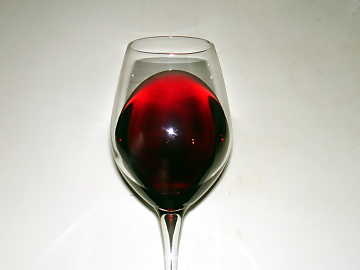 | |
| Color and
transparency of Barbera d'Asti | |
|
Barbera, besides being widely cultivated in Piedmont and in many regions of
Italy, is also cultivated in other viticultural areas of the world, such as
California and Argentina. A grape having a strong acidity, Barbera it is not
particularly rich in polyphenols, making wines of crisp agreeableness and
moderate astringency. The Piedmontese red grape proved with time interesting
wine making versatility, as well as proving to be well suited for the
production of different styles, including pleasing slightly sparkling wines.
Barbera is now very successful in the world, becoming one of the grapes part of
the Olympus of Bacchus during the 1990s, when drastic viticultural and wine
making changes took place all over Italy. These changes, characterized by the
research for quality and therefore the experimentation of new and modern wine
making techniques, have allowed Barbera to be reevaluated even in the
vinification in cask. Widely found in Piedmont, Barbera is a grape present in
many denomitations of the region and, in particular, Asti and Nizza Monferrato,
today recognized as Denominazione d'Origine Controllata e Garantita
areas. (Denomination of Controlled and Guaranteed Origin)
Our tasting by contrast will examine a Primitivo di Manduria and a Barbera
d'Asti. These two wines will let us understand their remarkable differences,
mainly expressed by the roundness and astringency in the first case, finesse
and crispness in the second. Barbera is cultivated in many areas of Piedmont
and each of them gives this grape characteristics strongly affected by soil
and territory. As opposed to Barbera wines from other areas of Piedmont, the
one produced in Asti is in fact characterized by a higher finesse and elegance.
Something completely different, for example, in those made in Alba having a
different composition of soil and characteristics of the territory, Barbera
wines here are more robust and full bodied. We will taste two wines having no
more than three year of aging and vinified in cask, therefore ensuring a good
balance between tertiary qualities and characteristics of the grapes. Wines
will be served in two tasting glasses at a temperature of 18 °C (65 °F).
Let's pour the two wines in their respective tasting glasses and start the
first part, the one about appearance evaluation. The first wine we will observe
is Primitivo di Manduria. Let's tilt the glass over a white surface - a napkin
or a sheet of paper will be enough - in order to assess the color at the base.
We will observe an intense ruby red color, sometimes deep, and a low
transparency: it will in fact be quite difficult to see an object behind the
glass. Nuances of the color, observed at the edge towards the opening of the
glass, will show an intense ruby red hue. Let's now pass to the evaluation of
Barbera d'Asti. The color of this wine shows to the eyes of the taster an
intense and brilliant ruby red color, while revealing a higher transparency
than Primitivo di Manduria. Nuance of Barbera d'Asti confirms a brilliant
ruby red hue. Let's now put the tilted glasses close one to each other and
compare both wines in order to understand differences in color and transparency.
Olfactory profiles of Primitivo and Barbera mainly express aromas of wild
berries. The famous grape from Apulia mainly expresses aromas recalling black
berried berries, whereas Barbera is more directly associated to red berries. In
both grapes will also be perceived aromas recalling flowers, in particular
violet. In Primitivo will be mainly perceived aromas of black cherry, plum and
blackberry, whereas in Barbera will be cherry, raspberry and plum, also
blackberry will be perceived sometimes. Both grapes offer a good versatility in
the vinification in wood containers, a technique enriching the olfactory
profiles of both wines with a higher complexity. Primitivo and Barbera,
according to viticultural and wine making techniques, are capable of making
wines with a good longevity and excellent chances of evolution. With time,
these two varieties - provided they are kept in very good conditions - can in
fact enrich their aromas with very complex sensations, offering an excellent
case study to the nose of the taster.
The first wine of which we will evaluate the olfactory profile is Barbera
d'Asti. Let's hold the glass in vertical position and without swirling, then
proceed with the first smell. To the nose are perceived aromas of cherry,
raspberry and plum, followed by violet. Let's now swirl the glass in order to
favor the development of aromas and, by tilting it, do a second smell. It will
be perceived aromas recalling blackberry as well as sensations associated to
wood, such as vanilla. Let's now pass to the evaluation of the opening of
Primitivo di Manduria. The nose is evidently different and here it is perceived
black cherry, plum and blackberry followed by violet, sometimes ever dried.
After having swirled the glass, Primitivo completes its olfactory profile with
blueberry, carob and sensations given by wood. Sometimes, in this wine,
sensations of fruit can also get a character recalling jams. Let's now compare
the two wines: in Primitivo we will notice a fuller and rounder olfactory
profile than Barbera, in which will be perceived a more lively and crisp
character.
The gustatory analysis of the two wines let us continue the identification of
differences in Primitivo di Manduria and Barbera d'Asti. Let's start this phase
of the tasting by evaluating the Piedmontese wine. We will take a sip of
Barbera d'Asti: the attack of this wine reveals the crisp character of this
grape giving to the taste an evident acidic component, however very elegant. It
should also be noticed the astringency in this wine, perceptible however not
aggressive. In the mouth are perceived flavors of cherry, plum and raspberry,
as well as the evident warm sensation of alcohol. The attack of Primitivo di
Manduria is rounder and smoother than Barbera d'Asti, in which is also
perceived a stronger astringency of tannins and a fuller body. In the wine from
Apulia is also perceived a stronger effect of the alcohol, a characteristic
also increasing the perception of roundness. The correspondence to the nose is
very good: the perception of black cherry, blackberry and plum are dominant.
The ending part of our tasting is about the final sensations perceived in the
mouth and nose after having swallowed the wines. The finish of Barbera d'Asti
has a good persistence, leaving in the mouth its typical flavors of fruits: in
particular cherry, raspberry and blueberry. Crispness of acidity continues to
be well perceived in the mouth after having swallowed the wine, leaving a
sensation of pleasing elegance. The finish of Primitivo di Manduria is quite
different from Barbera, also in this case having a good persistence. The
sensation left in the mouth by the wine from Apulia is fuller and rounder, in
which can also be perceived the burning effect of alcohol. It will also
be perceived the typical flavors of this variety, in particular blackberry,
plum and black cherry. According to a sensorial point of view, Primitivo and
Barbera are two distant varieties, very different enological expressions
however both capable of making wines of extraordinary and high quality.
|


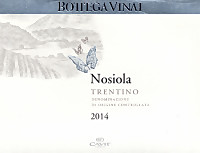
 Nosiola
Nosiola Intense greenish yellow and nuances of greenish yellow.
Intense greenish yellow and nuances of greenish yellow. Intense, clean and pleasing, starts with hints of green apple, pear and
broom followed by aromas of peach, hazelnut, hawthorn and pineapple.
Intense, clean and pleasing, starts with hints of green apple, pear and
broom followed by aromas of peach, hazelnut, hawthorn and pineapple.
 Crisp attack and however balanced by alcohol, good body, intense
flavors, agreeable.
Crisp attack and however balanced by alcohol, good body, intense
flavors, agreeable.
 Persistent finish with flavors of green apple, pear and peach.
Persistent finish with flavors of green apple, pear and peach. Aged in steel tanks.
Aged in steel tanks. Vegetable and crustacean appetizers, Risotto with fish, Sauteed crustaceans
Vegetable and crustacean appetizers, Risotto with fish, Sauteed crustaceans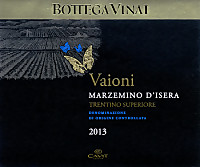
 Marzemino
Marzemino Intense ruby red and nuances of ruby red, little transparency.
Intense ruby red and nuances of ruby red, little transparency. Intense, clean, pleasing and refined, starts with hints of black
cherry, violet and blueberry followed by aromas of raspberry, pomegranate,
plum, cyclamen, geranium, blackberry and pink pepper.
Intense, clean, pleasing and refined, starts with hints of black
cherry, violet and blueberry followed by aromas of raspberry, pomegranate,
plum, cyclamen, geranium, blackberry and pink pepper.
 Properly tannic attack and however balanced by alcohol, good body,
intense flavors, pleasing crispness.
Properly tannic attack and however balanced by alcohol, good body,
intense flavors, pleasing crispness.
 Persistent finish with flavors of black cherry, blueberry and
raspberry.
Persistent finish with flavors of black cherry, blueberry and
raspberry.
 6 months in steel tanks, 4 months in bottle.
6 months in steel tanks, 4 months in bottle. Cold cuts, Stuffed pasta with meat, Stewed meat with mushrooms, Cheese
Cold cuts, Stuffed pasta with meat, Stewed meat with mushrooms, Cheese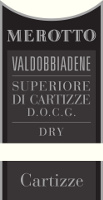
 Glera
Glera Intense greenish yellow and nuances of greenish yellow, very
transparent, fine and persistent perlage.
Intense greenish yellow and nuances of greenish yellow, very
transparent, fine and persistent perlage.
 Intense, clean, pleasing and refined, starts with hints of apple, peach
and wistaria followed by aromas of pear, jasmine, broom, tangerine, plum
and pineapple.
Intense, clean, pleasing and refined, starts with hints of apple, peach
and wistaria followed by aromas of pear, jasmine, broom, tangerine, plum
and pineapple.
 Effervescent attack and pleasing sweetness, however balanced by
alcohol, good body, intense flavors, pleasing crispness.
Effervescent attack and pleasing sweetness, however balanced by
alcohol, good body, intense flavors, pleasing crispness.
 Persistent finish with flavors of apple, peach and pineapple.
Persistent finish with flavors of apple, peach and pineapple. Produced with the Charmat method.
Produced with the Charmat method. Aperitifs, Crustacean appetizers, Sauteed crustaceans, Risotto with vegetables
Aperitifs, Crustacean appetizers, Sauteed crustaceans, Risotto with vegetables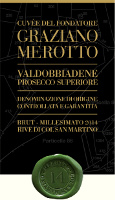
 Glera
Glera Intense greenish yellow and nuances of greenish yellow, very
transparent, fine and persistent perlage.
Intense greenish yellow and nuances of greenish yellow, very
transparent, fine and persistent perlage.
 Intense, clean, pleasing, refined and elegant, starts with hints of
pear, wistaria and apple followed by aromas of peach, broom, hawthorn,
tangerine, pineapple, plum and mineral.
Intense, clean, pleasing, refined and elegant, starts with hints of
pear, wistaria and apple followed by aromas of peach, broom, hawthorn,
tangerine, pineapple, plum and mineral.
 Effervescent and crisp attack, however balanced by alcohol, good body,
intense flavors, agreeable.
Effervescent and crisp attack, however balanced by alcohol, good body,
intense flavors, agreeable.
 Persistent finish with flavors of pear, apple and peach.
Persistent finish with flavors of pear, apple and peach. Fermented in closed tank for 50 days.
Fermented in closed tank for 50 days. Fish and crustacean appetizers, Sauteed crustaceans, Pasta and risotto with crustaceans
Fish and crustacean appetizers, Sauteed crustaceans, Pasta and risotto with crustaceans
 Friulano
Friulano Brilliant straw yellow and nuances of straw yellow, very transparent.
Brilliant straw yellow and nuances of straw yellow, very transparent. Intense, clean, pleasing and refined, starts with hints of apple, plum
and hawthorn followed by aromas of pear, peach, pineapple, almond, broom
and jasmine.
Intense, clean, pleasing and refined, starts with hints of apple, plum
and hawthorn followed by aromas of pear, peach, pineapple, almond, broom
and jasmine.
 Crisp attack and however balanced by alcohol, good body, intense
flavors, agreeable.
Crisp attack and however balanced by alcohol, good body, intense
flavors, agreeable.
 Persistent finish with flavors of apple, plum and almond.
Persistent finish with flavors of apple, plum and almond. Aged in steel tanks.
Aged in steel tanks. Pasta and risotto with fish and crustaceans, Sauteed white meat, Fried fish
Pasta and risotto with fish and crustaceans, Sauteed white meat, Fried fish
 Sauvignon Blanc (40%), Friulano (20%), Chardonnay (20%), Pinot Bianco (20%)
Sauvignon Blanc (40%), Friulano (20%), Chardonnay (20%), Pinot Bianco (20%) Brilliant straw yellow and nuances of straw yellow, very transparent.
Brilliant straw yellow and nuances of straw yellow, very transparent. Intense, clean, pleasing and refined, starts with hints of apple, plum
and banana followed by aromas of ripe peach, pear, elder, grapefruit,
hawthorn, mineral and hints of vanilla.
Intense, clean, pleasing and refined, starts with hints of apple, plum
and banana followed by aromas of ripe peach, pear, elder, grapefruit,
hawthorn, mineral and hints of vanilla.
 Crisp attack and however balanced by alcohol, good body, intense
flavors, pleasing roundness.
Crisp attack and however balanced by alcohol, good body, intense
flavors, pleasing roundness.
 Persistent finish with flavors of apple, plum and pear.
Persistent finish with flavors of apple, plum and pear. Aged in cask.
Aged in cask. Fish soups, Pasta and risotto with fish and crustaceans, Broiled fish
Fish soups, Pasta and risotto with fish and crustaceans, Broiled fish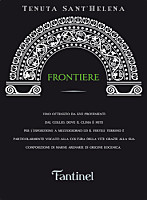
 Tocai Friulano (50%), Pinot Bianco (30%), Chardonnay (20%)
Tocai Friulano (50%), Pinot Bianco (30%), Chardonnay (20%) Intense straw yellow and nuances of straw yellow, very transparent.
Intense straw yellow and nuances of straw yellow, very transparent. Intense, clean, pleasing and refined, starts with hints of apple,
citrus fruits and jasmine followed by aromas of pear, peach, hawthorn,
banana, honey, almond, mineral and hints of vanilla.
Intense, clean, pleasing and refined, starts with hints of apple,
citrus fruits and jasmine followed by aromas of pear, peach, hawthorn,
banana, honey, almond, mineral and hints of vanilla.
 Crisp attack and however balanced by alcohol, good body, intense
flavors, pleasing roundness.
Crisp attack and however balanced by alcohol, good body, intense
flavors, pleasing roundness.
 Persistent finish with flavors of apple, plum and banana.
Persistent finish with flavors of apple, plum and banana. Part of the wine ferments in cask.
Part of the wine ferments in cask. Stuffed pasta with fish, Roasted white meat, Roasted fish, Mushroom soups
Stuffed pasta with fish, Roasted white meat, Roasted fish, Mushroom soups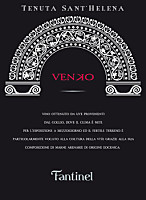
 Merlot (50%), Cabernet Franc (40%), Pinot Nero (10%)
Merlot (50%), Cabernet Franc (40%), Pinot Nero (10%) Deep ruby red and nuances of garnet red, little transparency.
Deep ruby red and nuances of garnet red, little transparency. Intense, clean, pleasing, refined and elegant, starts with hints of
plum, black currant and black cherry followed by aromas of dried violet,
blueberry, vanilla, tobacco, iris, chocolate, pink pepper, mace and
menthol.
Intense, clean, pleasing, refined and elegant, starts with hints of
plum, black currant and black cherry followed by aromas of dried violet,
blueberry, vanilla, tobacco, iris, chocolate, pink pepper, mace and
menthol.
 Properly tannic attack and however balanced by alcohol, good body,
intense flavors, pleasing roundness.
Properly tannic attack and however balanced by alcohol, good body,
intense flavors, pleasing roundness.
 Persistent finish with flavors of plum, black currant and black cherry.
Persistent finish with flavors of plum, black currant and black cherry. 24 months in cask.
24 months in cask. Roasted meat, Broiled meat and barbecue, Stewed and braised meat with mushrooms, Hard cheese
Roasted meat, Broiled meat and barbecue, Stewed and braised meat with mushrooms, Hard cheese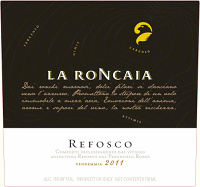
 Refosco dal Peduncolo Rosso
Refosco dal Peduncolo Rosso Intense ruby red and nuances of ruby red, little transparency.
Intense ruby red and nuances of ruby red, little transparency. Intense, clean, pleasing, refined and elegant, starts with hints of
black cherry, plum and black currant followed by aromas of blueberry,
violet, vanilla, raspberry, tobacco, chocolate, mace, pink pepper and
eucalyptus.
Intense, clean, pleasing, refined and elegant, starts with hints of
black cherry, plum and black currant followed by aromas of blueberry,
violet, vanilla, raspberry, tobacco, chocolate, mace, pink pepper and
eucalyptus.
 Properly tannic attack and however balanced by alcohol, good body,
intense flavors, pleasing roundness.
Properly tannic attack and however balanced by alcohol, good body,
intense flavors, pleasing roundness.
 Persistent finish with flavors of black cherry, plum and black currant.
Persistent finish with flavors of black cherry, plum and black currant. 18 months in barrique, 6 months in bottle.
18 months in barrique, 6 months in bottle. Roasted meat, Broiled meat and barbecue, Stewed and braised meat with mushrooms, Hard cheese
Roasted meat, Broiled meat and barbecue, Stewed and braised meat with mushrooms, Hard cheese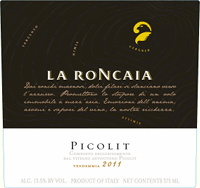
 Picolit
Picolit Brilliant amber yellow and nuances of amber yellow, transparent.
Brilliant amber yellow and nuances of amber yellow, transparent. Intense, clean, pleasing, refined and elegant, starts with hints of
raisin, dried apricot and acacia honey followed by aromas of quince jam,
date, peach jam, candied fruits, citrus fruit peel, chamomile, vanilla,
lavender and nail polish.
Intense, clean, pleasing, refined and elegant, starts with hints of
raisin, dried apricot and acacia honey followed by aromas of quince jam,
date, peach jam, candied fruits, citrus fruit peel, chamomile, vanilla,
lavender and nail polish.
 Sweet and round attack, however balanced by alcohol, good body, intense
flavors, pleasing crispness.
Sweet and round attack, however balanced by alcohol, good body, intense
flavors, pleasing crispness.
 Persistent finish with flavors of raisin, dried apricot and acacia
honey.
Persistent finish with flavors of raisin, dried apricot and acacia
honey.
 12 months in barrique, 6 months in bottle.
12 months in barrique, 6 months in bottle. Dried fruit and jam tarts, Hard cheese
Dried fruit and jam tarts, Hard cheese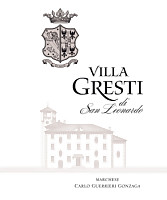
 Merlot (90%), Carmenère (10%)
Merlot (90%), Carmenère (10%) Intense ruby red and nuances of garnet red, little transparency.
Intense ruby red and nuances of garnet red, little transparency. Intense, clean, pleasing, refined and elegant, starts with hints of
black currant, black cherry and plum followed by aromas of violet,
blueberry, iris, raspberry, vanilla, tobacco, chocolate, face powder, pink
pepper, cigar box and eucalyptus.
Intense, clean, pleasing, refined and elegant, starts with hints of
black currant, black cherry and plum followed by aromas of violet,
blueberry, iris, raspberry, vanilla, tobacco, chocolate, face powder, pink
pepper, cigar box and eucalyptus.
 Properly tannic attack and however balanced by alcohol, full body,
intense flavors, pleasing roundness.
Properly tannic attack and however balanced by alcohol, full body,
intense flavors, pleasing roundness.
 Very persistent finish with long flavors of black currant, black cherry
and plum.
Very persistent finish with long flavors of black currant, black cherry
and plum.
 14 months in barrique, 12 months in bottle.
14 months in barrique, 12 months in bottle. Game, Roasted meat, Stewed and braised meat, Hard cheese
Game, Roasted meat, Stewed and braised meat, Hard cheese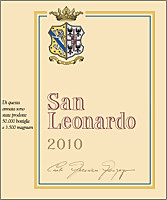
 Cabernet Sauvignon (60%), Carménère (20%), Cabernet Franc (10%), Merlot (10%)
Cabernet Sauvignon (60%), Carménère (20%), Cabernet Franc (10%), Merlot (10%) Intense ruby red and nuances of garnet red, little transparency.
Intense ruby red and nuances of garnet red, little transparency. Intense, clean, pleasing, refined and elegant, starts with hints of
black currant, black cherry and violet followed by aromas of blueberry, plum,
iris, vanilla, cocoa, tobacco, coffee, mace, pink pepper, green bell
pepper, cigar box, clove and eucalyptus.
Intense, clean, pleasing, refined and elegant, starts with hints of
black currant, black cherry and violet followed by aromas of blueberry, plum,
iris, vanilla, cocoa, tobacco, coffee, mace, pink pepper, green bell
pepper, cigar box, clove and eucalyptus.
 Tannic attack and however balanced by alcohol, full body, intense
flavors, agreeable.
Tannic attack and however balanced by alcohol, full body, intense
flavors, agreeable.
 Very persistent finish with long flavors of black currant, black cherry
and blueberry.
Very persistent finish with long flavors of black currant, black cherry
and blueberry.
 24 months in barrique, 12 months in bottle.
24 months in barrique, 12 months in bottle. Game, Roasted meat, Stewed and braised meat, Hard cheese
Game, Roasted meat, Stewed and braised meat, Hard cheese
